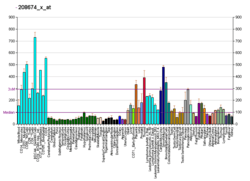DDOST
Dolichyl-diphosphooligosaccharide—protein glycosyltransferase 48 kDa subunit is an enzyme that in humans is encoded by the DDOST gene.[5][6]
This gene encodes a component of the oligosaccharyltransferase complex which catalyzes the transfer of high-mannose oligosaccharides to asparagine residues on nascent polypeptides in the lumen of the rough endoplasmic reticulum. The protein complex co-purifies with ribosomes. The product of this gene is also implicated in the processing of advanced glycation endproducts (AGEs), which form from non-enzymatic reactions between sugars and proteins or lipids and are associated with aging and hyperglycemia.[6]
References
- 1 2 3 GRCh38: Ensembl release 89: ENSG00000244038 - Ensembl, May 2017
- 1 2 3 GRCm38: Ensembl release 89: ENSMUSG00000028757 - Ensembl, May 2017
- ↑ "Human PubMed Reference:".
- ↑ "Mouse PubMed Reference:".
- ↑ Yamagata T, Tsuru T, Momoi MY, Suwa K, Nozaki Y, Mukasa T, Ohashi H, Fukushima Y, Momoi T (Jan 1998). "Genome organization of human 48-kDa oligosaccharyltransferase (DDOST)". Genomics. 45 (3): 535–40. doi:10.1006/geno.1997.4966. PMID 9367678.
- 1 2 "Entrez Gene: DDOST dolichyl-diphosphooligosaccharide-protein glycosyltransferase".
Further reading
- Kumar V, Korza G, Heinemann FS, Ozols J (1995). "Human oligosaccharyltransferase: isolation, characterization, and the complete amino acid sequence of 50-kDa subunit". Arch. Biochem. Biophys. 320 (2): 217–23. doi:10.1016/0003-9861(95)90003-9. PMID 7625827.
- Nagase T, Miyajima N, Tanaka A, et al. (1995). "Prediction of the coding sequences of unidentified human genes. III. The coding sequences of 40 new genes (KIAA0081-KIAA0120) deduced by analysis of cDNA clones from human cell line KG-1". DNA Res. 2 (1): 37–43. doi:10.1093/dnares/2.1.37. PMID 7788527.
- Stitt AW, He C, Vlassara H (1999). "Characterization of the advanced glycation end-product receptor complex in human vascular endothelial cells". Biochem. Biophys. Res. Commun. 256 (3): 549–56. doi:10.1006/bbrc.1999.0291. PMID 10080935.
- Strausberg RL, Feingold EA, Grouse LH, et al. (2003). "Generation and initial analysis of more than 15,000 full-length human and mouse cDNA sequences". Proc. Natl. Acad. Sci. U.S.A. 99 (26): 16899–903. doi:10.1073/pnas.242603899. PMC 139241. PMID 12477932.
- Lu C, He JC, Cai W, et al. (2004). "Advanced glycation endproduct (AGE) receptor 1 is a negative regulator of the inflammatory response to AGE in mesangial cells". Proc. Natl. Acad. Sci. U.S.A. 101 (32): 11767–72. doi:10.1073/pnas.0401588101. PMC 511050. PMID 15289604.
- Suzuki Y, Yamashita R, Shirota M, et al. (2004). "Sequence Comparison of Human and Mouse Genes Reveals a Homologous Block Structure in the Promoter Regions". Genome Res. 14 (9): 1711–8. doi:10.1101/gr.2435604. PMC 515316. PMID 15342556.
- Gerhard DS, Wagner L, Feingold EA, et al. (2004). "The Status, Quality, and Expansion of the NIH Full-Length cDNA Project: The Mammalian Gene Collection (MGC)". Genome Res. 14 (10B): 2121–7. doi:10.1101/gr.2596504. PMC 528928. PMID 15489334.
- Shibatani T, David LL, McCormack AL, et al. (2005). "Proteomic analysis of mammalian oligosaccharyltransferase reveals multiple subcomplexes that contain Sec61, TRAP, and two potential new subunits". Biochemistry. 44 (16): 5982–92. doi:10.1021/bi047328f. PMID 15835887.
- Ewing RM, Chu P, Elisma F, et al. (2007). "Large-scale mapping of human protein–protein interactions by mass spectrometry". Mol. Syst. Biol. 3 (1): 89. doi:10.1038/msb4100134. PMC 1847948. PMID 17353931.
This article is issued from
Wikipedia.
The text is licensed under Creative Commons - Attribution - Sharealike.
Additional terms may apply for the media files.





